Search
Viewing 1395 to 1410 of 3076 news
-
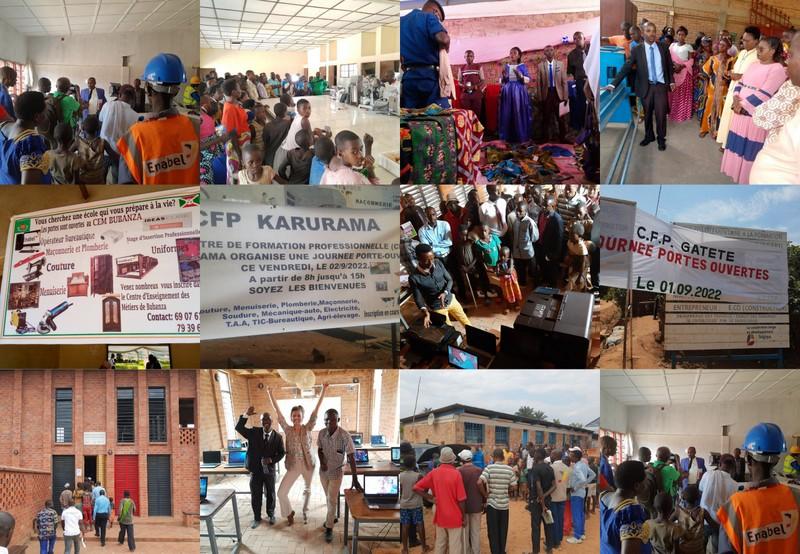
Burundi : Les Centres d’enseignement des métiers ouvrent leurs portes pour la communauté
Donavine KWIZERA | 16/09/2022
Les journées portes ouvertes ont été organisées pendant la semaine du 29 Août au 4 Septembre 2022 dans 15 centres d’enseignement des métiers (CEM) appuyés par le projet d’Appui Complémentaire à la Formation Professionnelle et Technique (ACFPT)/Enabel pour renforcer l’attractivité et la visibilité de ces centres avant la nouvelle rentrée scolaire;Initié par le projet ACFPT depuis 2017, les JPO attirent de plus en plus de gens surtout, la communauté environnante que ce soit les jeunes, les parents, les artisans ils viennent nombreux pour découvrir les CEM. Cette année, les journées portes ouvertes ont eu une particularité car elles ont été organisées toutes dans la même semaine afin de susciter l’intérêt des jeunes avant la période d’inscription. Il s’agit d’une activité importante d’ouverture à la communauté mais surtout qui contribue au renforcement de la visibilité et de l’attractivité des centres. Les participants à ces JPO ont eu droit à une visite guidée dans tous les coins de l’école par le personnel du centre, tous les ateliers des différentes filières ont été ouverts pour intéresser les visiteurs, ces derniers ont aussi eu droit à des démonstrations. Les journées portes ouvertes sont une bonne occasion pour présenter les différentes activités des CEM. Elles permettent de mettre en valeur l’expertise des centres, dans tel ou tel métier/domaine, leur savoir-faire est connu et affirmé grâce à ces journées. En faisant visiter les participants, les CEM font découvrir leur école, leurs équipements, les unités de production, ce qui renforce leur visibilité. C’est aussi un moment privilégié pour présenter l’offre de formations, les nouveautés, le processus d’innovation… et pourquoi pas vendre certains de leurs produits. Les JPO organisées par les centres répondent à deux objectifs principaux. Le premier étant de susciter un intérêt pour les jeunes de la communauté à s’inscrire pour la prochaine rentrée car les jeunes y participant reçoivent des informations complémentaires sur les formations en cours et cela les éclaire sur telle ou telle autre filière et crée l’envie de s’orienter vers un métier. Le second objectif est la promotion les Unités d’Appui Pédagogique (UAP) qui sont des unités qui produisent pour le marché tout en étant un lieu de pratique pour les lauréats."Sans cette journée porte ouverte, je n’aurai jamais su, ce qui est fait et enseigné dans ce centre " nous a confié un des participants à la JPO au CEM Mugutu dans la province de Gitega.L’un des succès enregistrés dans ces JPO 2022 est la participation et l’implication des autorités administratives, ils ont promis un soutien dans la valorisation de l’enseignement des métiers dans leurs localités respectives ainsi que la mobilisation pour les inscriptions.
-
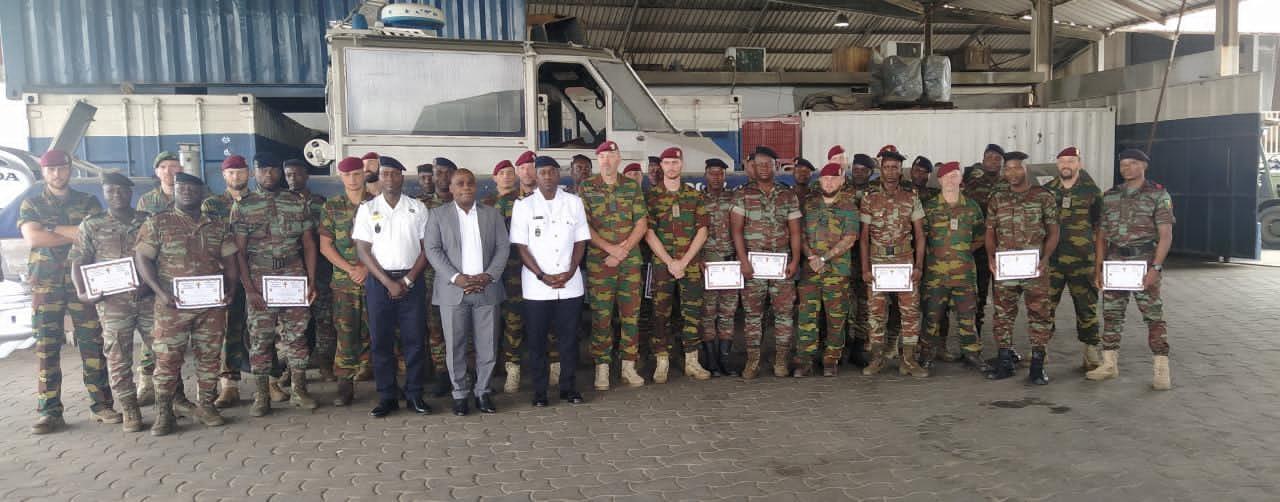
Bénin: 20 marins du port de Cotonou bénéficient de formations en réparation et pilotage d’embarcations pneumatiques
Reece-hermine ADANWENON | 15/09/2022
Dans le cadre de la mise en œuvre de son volet d’appui à l’amélioration de la sûreté maritime, le Projet d’Appui au développement du Secteur Portuaire (PASPort), Enabel a signé avec la Défense Belge, un accord spécifique de coopération ayant pour principal objet, la mobilisation de son expertise pour la mise en œuvre de certaines activités. L’essentiel de ces activités est relatif à la formation de la Marine Nationale ou d’autres entités/unités intervenant en mer. L’objectif de PASPort, ce faisant, est de contribuer à l’accroissement de la confiance des armateurs et des clients du Port de Cotonou aux eaux béninoises et ainsi contribuer à l’amélioration de la compétitivité du Port.Au nombre des formations planifiées pour l’année 2022, figure celle relative à la réparation et au pilotage des embarcations. Cette formation qui s’est déroulée du 8 au 26 Août 2022 à la Base Navale de Cotonou (BNCO) et animée par 14 militaires belges a permis à 20 marins béninois de renforcer leurs capacités en : i) conduite d’embarcations de types zodiacs et fluvial, ii) "self defense" (combat rapproché), iii) maintenance des embarcations, iv) manœuvre et v) secourisme. La formation a été faite d’apport théorique (1 semaine) et d’exercices pratiques en mer et sur le lac Nokoué (2 semaines).Cette formation a été sanctionnée par une cérémonie de remise de certificats de participation aux récipiendaires présidée par le nouvel attaché à la défense près l’ambassade de Belgique au Bénin (le Lieutenant-colonel Cédric Billiet), le Commandant de la Base Navale de Cotonou (le Capitaine de Vaisseau Franck SAIZONOU) et le projet PASPort représenté par Jérôme OZA. Aux dires du Commandant de la BNCO, les marins béninois ont toujours ressenti une grande satisfaction par rapport aux formations animées par les militaires belges en raison de leur engagement très élevé, leur fort dévouement et leur grande disponibilité et envie à transférer des connaissances. Il a précisé que cette formation/recyclage a permis aux marins formés de se remettre à niveau pour des missions de persuasion et de réponses à des alertes d’actes illicites dans les eaux maritimes béninoises. Il n’a pas manqué d’exprimer à nouveau sa gratitude à l’endroit de la Belgique et particulièrement d’Enabel pour son constant appui pour plus d’efficacité dans les interventions de la Marine Béninoise. Quant à l’attaché de défense, il s’est dit satisfait de la collaboration entre Enabel (PASPort) et l’Ambassade de la Belgique et a réitéré la disponibilité de la défense belge à accompagner la Marine Béninoise pour l’amélioration de ses capacités d’intervention en mer et dans les cours d’eaux intérieures. Une nouvelle formation est prévue pour le mois de Décembre sur le renseignement militaire dénommée « Basic Intelligence Course (BIOC) ». Il s’agit d’une nouvelle session de cette formation dont la première s’est déroulée en décembre 2021. Elle vient à point nommé vu la recrudescence des actes de piraterie dans le golfe de guinée.
-
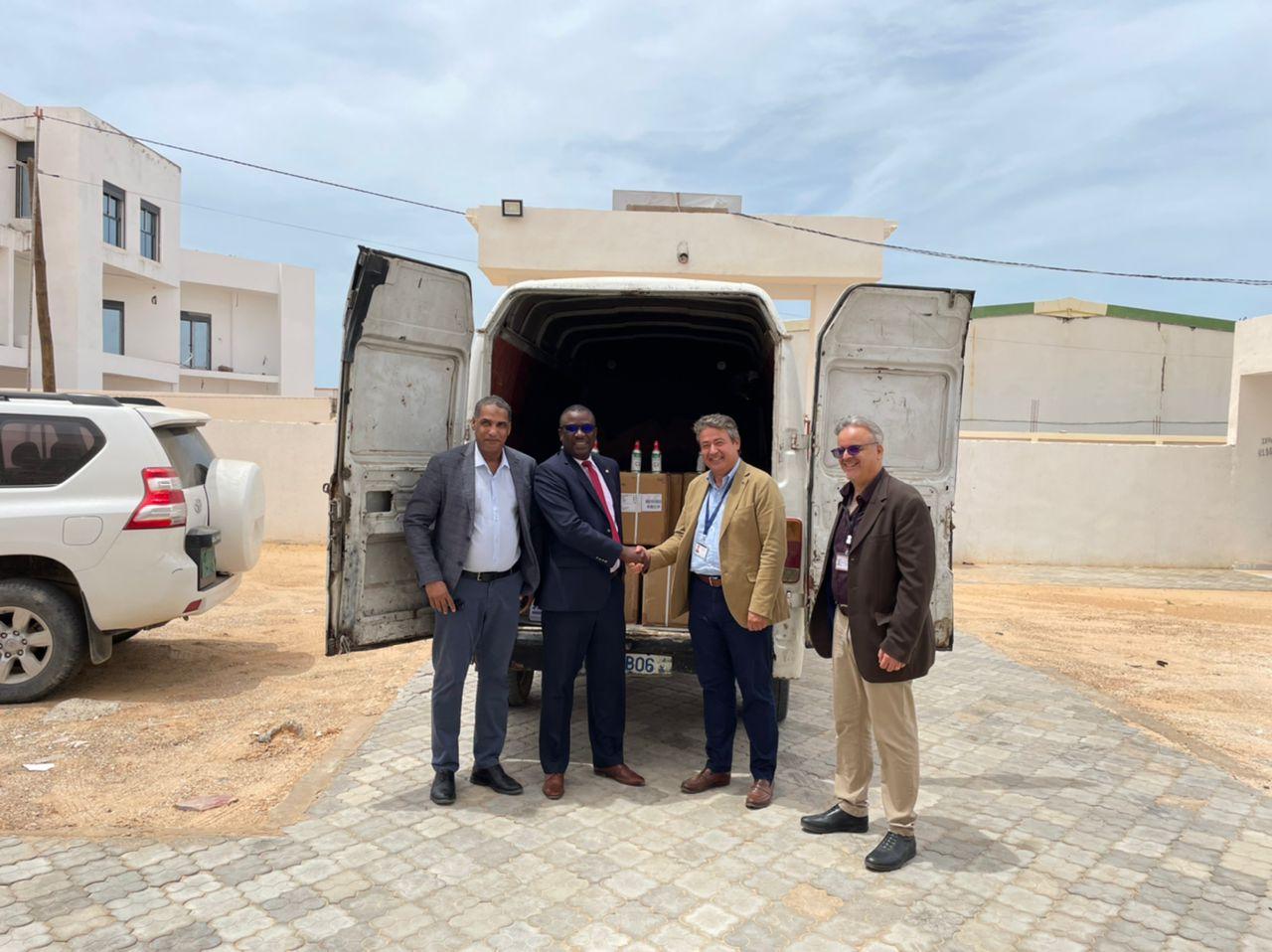
Enabel soutient la Mauritanie dans sa lutte contre la fièvre de la vallée du Rift
Aminata KANE | 14/09/2022
Le 14 septembre 2022, le Programme RIMFIL mis en œuvre par Enabel et financé par l’Union européenne a fourni à la Mauritanie son soutien contre l’apparition de la fièvre de la vallée du Rift. Un appui à la prévention de cette redoutable maladie qui touche le pays actuellement. Il s’agit d'un don de 2250 flacons de produits répulsifs destinés à couper le cycle de transmission chez les animaux du virus responsable de la maladie (moustiques).La cérémonie de remise s’est déroulée à la Direction des Services Vétérinaires en présence de Monsieur Jean-Marc DEWERPE ALVARO, Premier conseiller chef de coopération à la Délégation de l’Union européenne , du Dr Abderrhmane Benderdouche, Expert promotion filières agricoles et pastorales à l’Agence Belge de Développement RIMFIL (Promotion des filières agricoles et pastorales durables), du Dr Mohamed Ould Baba Ould GUEYA Chargé de mission et du Dr DOUMBIA Baba, Directeur des services vétérinaires au Ministère de l’Elevage.
-
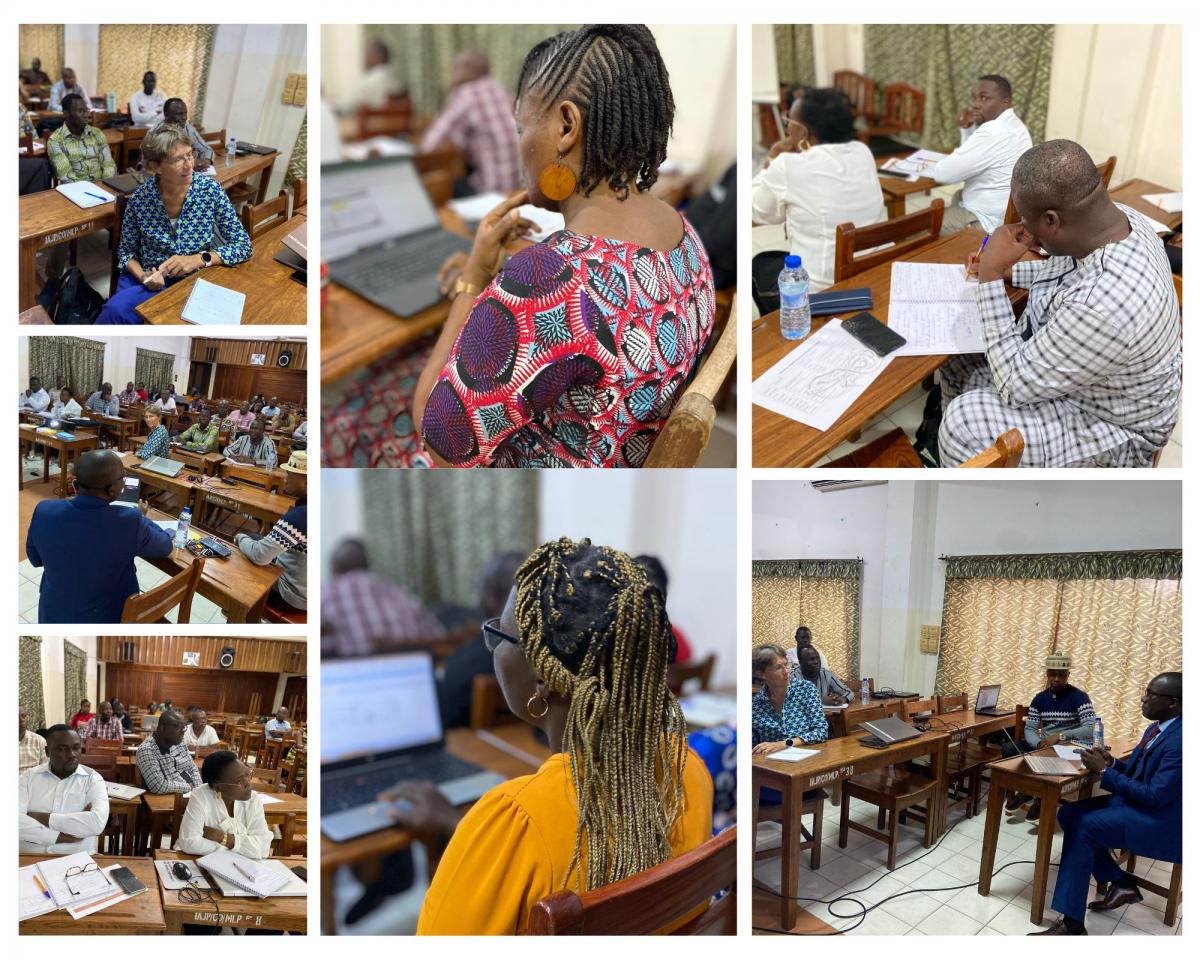
Au Bénin, plusieurs projets s’approprient le ToolBox sur l’entrepreneuriat des femmes
Reece-hermine ADANWENON | 12/09/2022
Comment élaborer et mettre en place des programmes adaptés pour le développement de l'entreprenariat féminin ? C’est à cet exercice que se livre le personnel des projets DEFIA (composante ananas et riz), PROFI (anacarde) et TAERA depuis ce lundi 12 Septembre 2022 au champ d’oiseau de Cotonou. Un exercice qui se base sur la boîte à outils « Toolbox for women entrepreneurs » développée par Enabel et Empowher et qui est dédiée à l’entrepreneuriat féminin afin de soutenir le leadership des femmes et réduire les inégalités de genre.Cette toolbox partagée lors de cet atelier avec les équipes des projets du Bénin permettra au personnel de délivrer des services adaptés aux besoins des femmes.Trois jours durant les participants à cet atelier de dissémination du Toolbox pourront : - renforcer leur compétence sur la thématique de genre et sur l’entrepreneuriat des femmes ;- rendre autonome les équipes dans l’utilisation et l’édition/enrichissement de la boîte à outils ; - former et sensibiliser les bénéficiaires des projets sur la thématique entrepreneuriat des femmes ;- développer des fiches thématiques genre et un outil de suivi des résultats sensible au genre. 04 grandes étapes méthodologique seront utilisées par les formateurs venus de la Guinée et du Burkina-Faso pour atteindre ces objectifs à savoir : - La Préparation et l’auto-diagnostique : (cette étape a permis de dresser un premier bilan de l’équipe de DEFIA-PROFI-TAERA sur les questions de genre)- Animation des formations sur site (organisation de deux journées de formation sur les contenus de la boîte à outils, afin de sensibiliser et faire monter en compétences l’équipes de DEFIA-PROFI-TAERA sur les questions de genre).- Sensibilisation sur terrain (Il s’agit d’organiser une journée de coanimation sur site d’une session de sensibilisation au genre)- Création de fiches thématiques et d’outil de suivi des résultats genre de DEFIA-PROFI-TAERA.
-
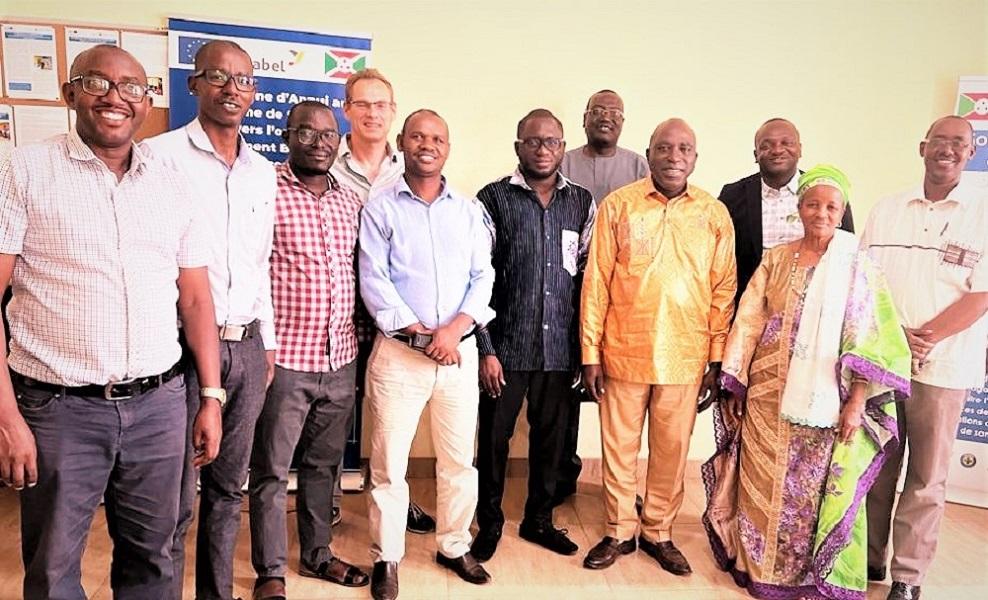
Burundi : Echanges de compétences - Enabel facilite un voyage d’étude du Ministère de la santé de Guinée au Burundi
Jean BIRONKWA | 12/09/2022
Avec l’appui de l’Enabel Guinée, une équipe du Ministère de la Santé de la République de Guinée a réalisé un voyage d’étude auprès du Ministère de la santé Publique et de la lutte contre le Sida du Burundi en dates du 28 août au 3 septembre 2022. Cette visite avait pour objectif d’échanger sur la stratégie de Financement Basé sur la Performance FBP et la gratuité au Burundi en général et en particulier le fonctionnement du Comité Provincial de Vérification et de Validation comme un système étatique de validation. Cette équipe est venue au Burundi en vue de s’inspirer de cette stratégie de financement vers l’agenda de la couverture sanitaire Universelle. En marge de cette visite de l’équipe de Guinée, des ateliers d’échanges ont été organisés entre la cellule technique nationale sur le financement basé sur la performance CT FBP du Ministère de la santé en chargé de la gestion du financement basé sur les performances mais aussi les comités provinciaux de vérification et de validation de Gitega et de Mwaro pour mieux comprendre cette stratégie. La délégation guinéenne a également rencontré la représentation d’Enabel au Burundi ainsi que l’équipe du Programme d’appui au système de santé Amagara Mu Muryango financé par l’Union Européenne et le Royaume de Belgique, qui depuis 2016 contribue à cette stratégie nationale de financement de la santé au Burundi. La représentation d’Enabel a partagé l’équipe de Guinée sa contribution technique et financière dans cette stratégie qui vise l’accès aux soins et services de santé pour les femmes enceintes et les enfants de moins de cinq ans.CetteL'équipe du Ministère de la Santé de la République de Guinée a signalé qu’Enabel accompagne également le Ministère de la santé de la Guinée à mettre en place une structure para étatique dans la stratégie de financement basé sur les résultats pour réduire le coût lié aux vérifications qui étaient jusqu’ici réalisées par des structures indépendantes recrutées pour cette fin. Cette structure étatique une fois mise en place en Guinée va également identifier les mesures de pérennisation de l’approche après le retrait des partenaires et préparer en même temps l’agenda de la couverture sanitaire universelle. L’équipe guinéenne a fait remarquer que le Burundi possède une grande expérience dans la mise en œuvre de la stratégie FBP -Gratuité appuyé par ses partenaires au développement d’où la raison de ce voyage d’étude qui cadre bien avec les prochaines étapes vers la couverture sanitaire universelle.
-
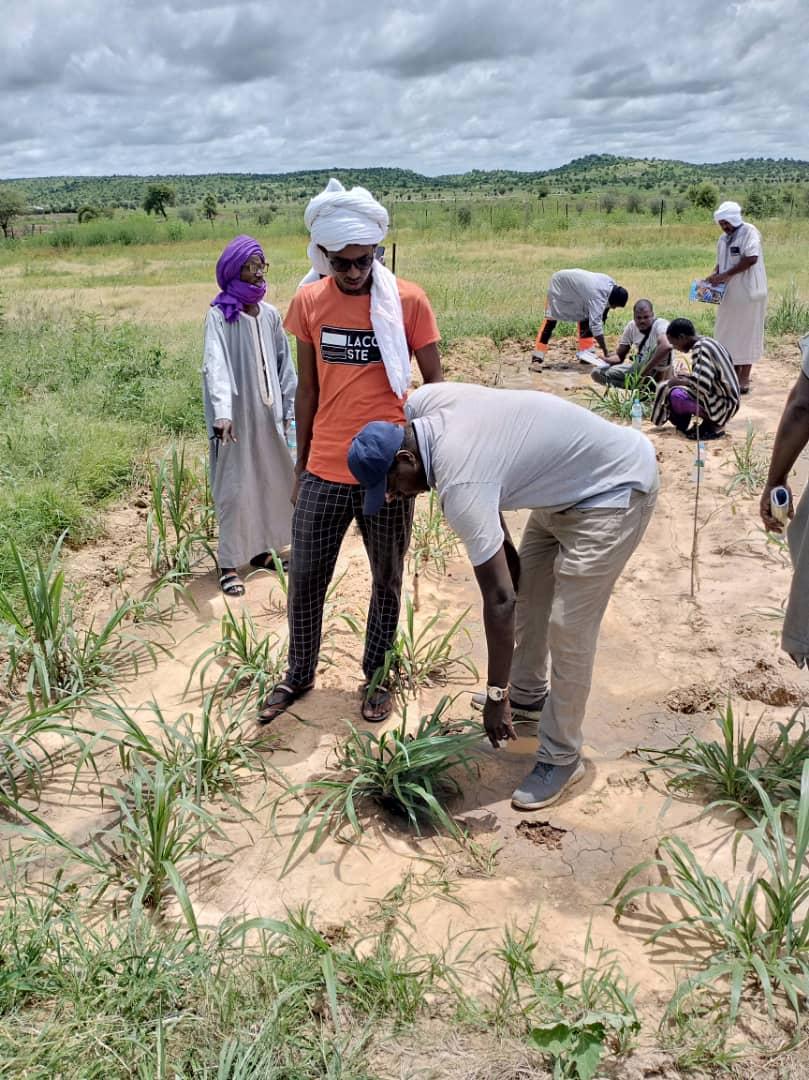
En Mauritanie, on renforce les capacités techniques et organisationnelles des organisations communautaires via les "Champs Ecoles Agro Pastoral"
Aminata KANE | 12/09/2022
Du 3/08/22 au 9/08/22 a eu lieu la cérémonie d’ouverture officielle de l’atelier de la première session de formation des facilitateurs champs-école-pastoral CEAP Année_2 à Gouraye qui a regroupé les facilitateurs pastoraux de L’Assaba et Guidimakha. Les participants sont: Le Coordinateur régional, Le Délégué régional de l’élevageLe Maire de la commune de Gouraye L'équipe des programmes Rimfil, Rimdir du Guidimakha Le Master-trainer et Les facilitateursL’approche CEAP est une démarche de vulgarisation participative qui vise le renforcement des capacités techniques et organisationnelles des organisations communautaires de producteurs pour la gestion efficace de leurs exploitations agro-pastorales. Tout comme les champs écoles de producteurs (CEP), le CEAP offre l’opportunité aux pasteurs et agro-pasteurs d’apprendre en pratiquant, en étant eux-mêmes impliqués dans l’expérimentation, les discussions et la prise de décisions. Ils constituent une plate-forme d’échanges interactifs entre le chercheur, le vulgarisateur, le producteur et permettent ainsi de valoriser les savoirs locaux. La session a débuté avec le mot de bienvenue du Maire suivi par la prise de parole du Coordinateur régional RIMDIR-RIMFIL pour présenter brièvement les projets RIMDIR RIMFIL, il a expliqué: les objectifs de la formation;les résultats attendus;l’approche CEAP; et le pourquoi du choix de la ville de Gouraye pour abriter la deuxième génération de formation pastoral Le maitre formateur a décliné le programme de la première session de formation qui se résume en 7 chapitres à savoir :Le concept champ école AgropastoralLa culture fourragèreLe curriculum de CEAP d’ENABEL La dynamique des groupes L’enquête de baseLes fiches de suivi du troupeauLe plan d’action de suivi Le maitre formateur a demandé ensuite à chaque facilitateur de décliner ses attentes par rapport à la formation qu’il va recevoir. Chaque facilitateur s’est présenté en indiquant la localité et son bassin de production. Les facilitateurs pastoraux se sont repartis en quatre groupe pour faciliter le travail pour faciliter les travaux pratiques. Chaque groupe a présenté brièvement ces attentes pour la formation quelques thématiques ont été soulevés par les facilitateur qui sont : La promotion de la culture fourragère;Valorisation du lait local;La santé animale, embouche bovine;Transformation du lait;Cultures fourragères;Stabulation des vaches laitières; Amélioration de la production;Mise en place de CF;Fauchage;Conditionnement; etAmélioration génétique des racesCes besoins ressorties permettent au maitre formateur de réorienter les activités de formation par rapport aux attentes des facilitateurs pastoraux. Les résultats obtenus de la formation sont:Le renforcement technique des facilitateurs pastoraux sur des techniques liés au développement de la filière laitière Année_2;L’échange d’expériences et de connaissances entre facilitateurs, avec l’apport éventuel de connaissances complémentaires par le Master-Trainer;La co-construction (conception, mise en place et évaluation) d’essais par le groupe de paysansMaitrise des techniques culturales des cultures fourragères (Maralfalfa, luzerne, pois d’engole, pois d’oligue, Niébé fourrager et Brachiaria);Le site de démonstration (champ-mère) est aménagé et les démonstrations techniques sont mis en œuvre; Les facilitateurs formés et entrainés à cet exercice sont prêts à l´intégrer dans leur site de production;Le plan d’action des facilitateurs est bien discuté et validé par tous pour cette campagne;Les facilitateurs étant un maillon de la filière laitière, se sont connus, concertés et leur liaison est établie;Les thématiques du curriculum de formation en CEAP focalisées sur la production laitière est validé avec les bénéficiaires;Un Plan de suivi régulier des Champs- école des facilitateurs (CEF) ou « Champs -école mère » et des CEAP associés aux CEF est élaboré;Un système de réseautage des facilitateurs (groupe Whatsapp) est créé; etUn outil de système de suivi sanitaire des troupeaux est mis en placeLa dernière journée de formation s’est focalisée sur l’évaluation du déroulement de l’atelier (leçons apprises, contraintes, recommandations). Les facilitateurs ont apprécié le contenu des enseignements et la démarche pédagogique du formateur. Les facilitateurs ont confirmé que le formateur n’est pas seulement un formateur mais plutôt un éducateur de haut niveau.Enfin, le coordinateur régional a remercié vivement les facilitateurs pour leur patience durant la formation. Par la suite le Maire s'est dit très satisfait et heureux de recevoir une formation de tel importance dans sa commune et à remercier Enabel pour la mise en place de l’initiative. Les autorités locales présentent ont mis en avant le fait que le programme répond aux besoins du gouvernement vu l'importance du secteur de l'élevage.
-
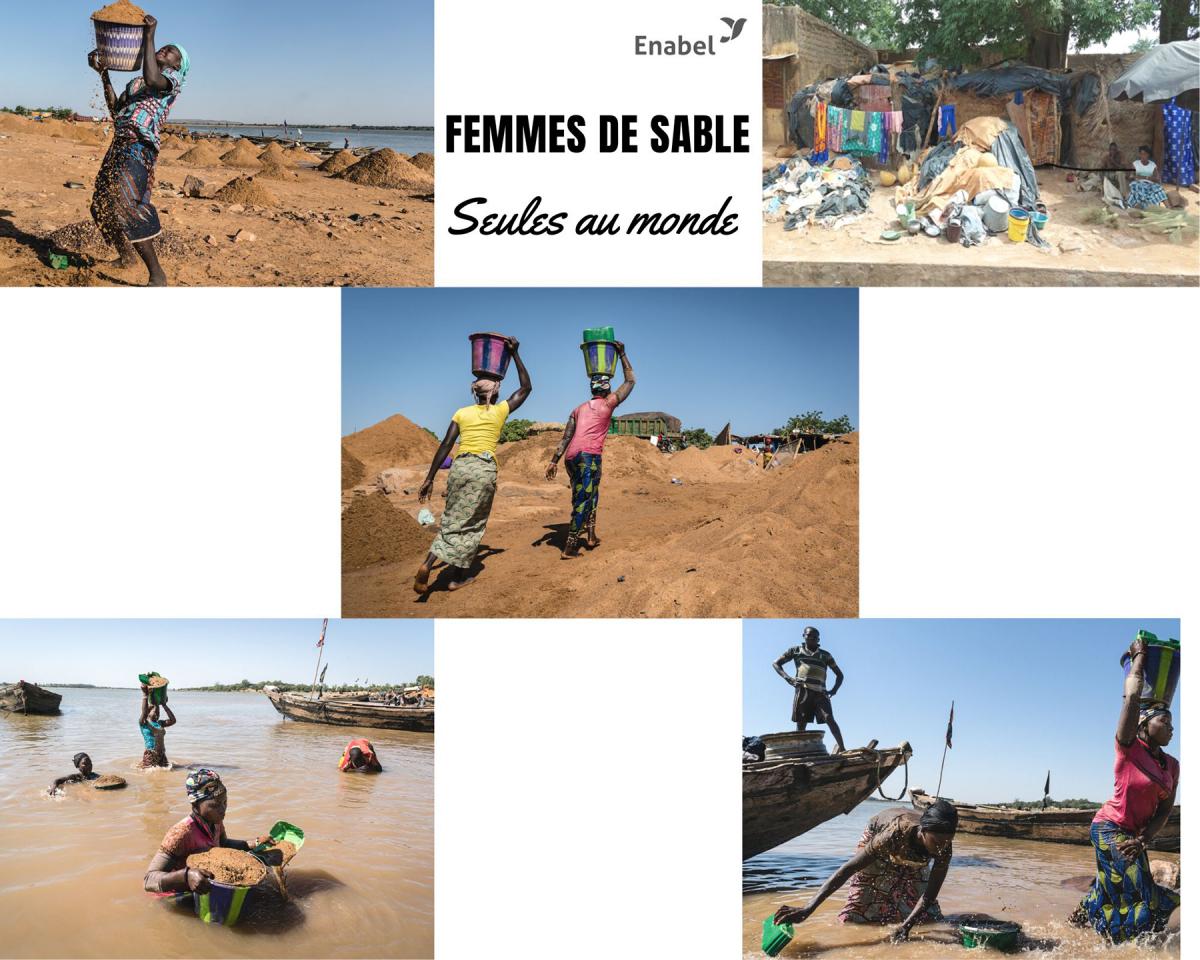
Au Mali, focus sur l'amélioration de conditions des femmes exploitantes de sable
Nènè TRAORE | 08/09/2022
Les femmes exploitantes de sable et de gravier dans la commune urbaine de Koulikoro au Mali Depuis 2021, Enabel dans la mise en œuvre de son projet renforcement des capacités (IRC) des institutions et acteurs de la société civile dans la région de Koulikoro a fait une recherche-action sur le genre pour trouver des solutions à la problématique de l’extraction de sable et de gravier par les filles et les femmes vulnérables. Les résultats issus de cette recherche abordent les points suivants : l’autonomisation économique, la santé, les droits sexuels et reproductifs et les violences basées sur le genre. En effet pour améliorer le statut et les conditions de travail des filles et des femmes vulnérables exploitantes de sable et de gravier dans le lit du fleuve Niger dans la commune urbaine de Koulikoro, au Mali, il est nécessaire d’encourager une autonomisation économique des femmes concernées. Il faut donc parvenir à une transformation sociale pour garantir un environnement sain et sécurisé pour les femmes et les filles exploitantes de sable et de gravier en protégeant les berges et le lit du fleuve Niger dans la commune urbaine de Koulikoro. Une recherche-action qui se déroule dans le lit du fleuve Niger à KoulikoroKoulikoro est une commune urbaine du Mali. La ville est située environ 60 kilomètres à l’est de Bamako. L’extraction de sable et de gravier dans le lit du fleuve Niger a commencé de façon occasionnelle à l’époque coloniale pour ensuite évoluer progressivement au fil de l’urbanisation de la ville de Bamako. Après la fermeture de l’Huilerie Cotonnière du Mali (HUICOMA), les populations de la commune de Koulikoro se sont tournées vers les activités d’extraction de sable et de gravier dans le lit du fleuve Niger afin de compenser la perte de revenu. Brusquement, les femmes dont les maris travaillaient à l’HUICOMA sont devenues des femmes chefs de famille. Des femmes pauvres, vulnérables, marginalisées mais oubliées dans tous les mécanismes de protection socialeDans le centre du Mali, de nos jours, les populations travaillent de moins en moins la terre en raison du conflit et de l’insécurité qu’il engendre. La plupart des habitants, notamment les filles et les femmes, préfèrent fuir vers les villes plus tranquilles comme la commune de Koulikoro. C’est ainsi que, du jour au lendemain, les berges du fleuve Niger ont été envahies par des milliers de femmes, de filles et de garçons de tout âge venant des quatre coins du Mali et des pays voisins, tels que le Burkina Faso, la Côte d’Ivoire et la Guinée. Dans ce monde hostile, la situation de certaines femmes et filles sur les sites d’extraction de sable dépasse ce que l’on peut imaginer car elles sont dans l’oubli total, sans famille, sans éducation, sans soins de santé, sans logement. Elles deviennent les victimes de toutes sortes de violences sexuelles et sociales, harcèlement physique et peuvent tomber dans la prostitution. Droits humains et autonomisation économique des femmes – un droit pour les femmes L’autonomisation des femmes et la promotion de l’égalité entre femmes et hommes constituent un principe cardinal. Ainsi, des formations ont été organisées pour équiper les femmes et booster leurs compétences théoriques et pratiques en matière de leadership féminin afin de conforter et de pérenniser leur engagement pour la parité. En outre, le projet a mis en place la formation d’un pool de quarante formateurs issus des organisations partenaires de l’IRC sur les approches et outils pour mener à bien des actions sensibles au genre dans le développement local. A la suite de cette démarche, il s’est révélé nécessaire de mieux comprendre le statut et la condition des femmes et filles extractrices de sable et de gravier dans le lit du fleuve Niger à Koulikoro afin de promouvoir leur autonomisation. Une recherche-action a été entamée pour identifier et, à terme, trouver des solutions idoines pour améliorer leur statut et leurs conditions de travail. Résultat de la recherche Cette recherche-action a permis d’identifier les problèmes des femmes et des filles extractrices de sable et de gravier et de formuler d’éventuelles solutions pour l’amélioration des conditions de travail et du statut des filles et femmes exploitantes en vue de leur autonomisation. Elle a aussi entraîné un changement des comportements individuels des membres du groupe : « Tout le monde est choqué par la découverte de la situation de violences basées sur le genre et de la perte de dignité humaine que vivent ces femmes dans l’oubli complet et l’indifférence totale ». Autonomisation économique des femmes et des filles Comment favoriser l’autonomisation économique des femmes exploitantes de sable et de gravier ?Parmi les solutions possibles figurent l’accès et le contrôle des ressources et la création d’activités génératrices de revenus. Le revenu mensuel moyen d’un homme est égal au revenu annuel moyen d’une femme. Les femmes travaillent entre sept et quinze heures par jour pour un revenu de 500 à 1 000 FCFA, qui peut varier selon les jours. Ce montant ne leur permet pas de manger, de se soigner et d’envoyer leurs enfants à l’école. Témoignage de Fatoumata, exploitante de sable à Koulikoro : « Je ne gagne pas assez d’argent. Je récolte le sable avec un morceau de bidon coupé et une tasse trouée. Je fais un tas avec quinze seaux que je peux vendre à 250 FCFA. Pour le chargement d’une charrette, je gagne 500 FCFA. Aucune femme ne dispose d’aire de stockage. Ce sont les hommes qui contrôlent tout et ce sont eux qui nous donnent de petits espaces pour nos tas de sable. Nous les femmes ne sont pas suffisamment équipés comme les hommes donc nous gagnons moins qu'eux, on manque de moyens, c'est un besoin réel qui nous handicape parfois J’ai notamment besoin de diversifier mes sources de revenus car pendant la saison des pluies avec la montée de l’eau du fleuve, nous n’arrivons pas à extraire le sable. De plus, c’est très dangereux. Beaucoup de mes camarades sont mortes par noyade. » En premier lieu, la formation des femmes à d’autres activités génératrices de revenus, telles que l’élevage de volaille ou de petits ruminants, le maraîchage et la transformation agroalimentaire, la saponification, le commerce, etc., est nécessaire pour favoriser leur autonomisation économique. En second lieu, elles doivent être impliquées dans les espaces de décisions sur les prix à fixer et dans les autres formes d’organisation sur les sites d’exploitation du sable, tels que les espaces de stockage. Enfin, il faut mettre à la disposition des femmes du matériel et des équipements adéquats pour l’extraction du sable. Témoignage de Kady, : « On a quitté Mopti il y a quatre ans en raison des conflits. Quand on est arrivé à Koulikoro, mon père est décédé. Je vis sur les berges avec ma mère et mes deux petits frères, sous un hangar que nous avons construit avec de vieux tissus et du plastique. Ma mère n'a pas d'emplois, donc j’ai décidé d’aller récolter le sable pour subvenir aux besoins de ma famille. Je pars à 5 heures et je rentre à 10 heures pour donner à ma mère l’argent pour la préparation du repas et ensuite je retourne aux berges du fleuve où je reste jusqu’à 19 heures. Il y a des jours où je ne gagne rien. Je pleure souvent quand je ne gagne pas d’argent. J'ai un enfant dont j' assure les frais de scolarité à travers les revenus du sable. Souvent, mon enfant est expulsé de l’école pour non-paiement des frais. Il passe une semaine à la maison, après je m’arrange pour payer. ». Violence basée sur le genre Les femmes sont victimes de violence verbale, d’injures graves venant des laptons (pêcheurs de sable, ils transportent le sable et font la plonge), d’insultes ; elles subissent des agressions physiques. Les laptons frappent les petites filles, les vieilles sont bousculées car elles les dérangent. Les filles subissent des agressions sexuelles, des viols. L’accès des filles et des jeunes femmes à la pirogue est conditionné à l’exploitation sexuelle. Elles sont obligées d’accepter les avances et les injonctions indécentes des laptons. Les survivantes ne bénéficient pas de prise en charge psychosociale en cas de viol ou d’agression sexuelle dans le cadre de leur activité. Ce sont les femmes elles-mêmes qui s’occupent des cas. Elles n’ont ni information ni accès aux services de prise en charge, tels que les centres d’écoute et de conseils juridiques. Les syndicats qui sont censés sensibiliser les pêcheurs de sable semblent être de mèche avec les agresseurs et n’entreprennent aucune démarche pour empêcher les abus. La voix des femmes ne porte pas suffisamment pour empêcher ce genre de pratiques sur les sites d’exploitation. Wassa a commencé à travailler à 8 ans et a dû combiner travail et scolarité. Elle témoigne : « J’ai commencé à travailler dans le sable depuis que je vais à l’école le matin jusqu’à 14 h. À la sortie de l’école, je vais au site et j’y travaille de 14h30 à 18 h. Le samedi et le dimanche, je travaille aussi, de 8 h à 18 h et on mange tous là-bas. Après, vers 21 h, je vais apprendre mes leçons. Je me couche à 1 h du matin et je me lève à 6 h. En journée, je ne veux pas dormir, parce que dormir, c’est perdre du temps. J’ai souvent mal au dos et à la poitrine. Quand j’ai commencé à travailler, à 8 ans, je n’avais pas mal au dos. Ça a commencé quand j’ai eu 10 ans et ça ne m’a plus jamais quittée. » Wassa rêve d’être policière. Mais elle a déjà échoué quatre fois aux tests de recrutement. Pour le reste, les formations coûtent de l’argent et sa famille n’a pas les moyens. « Oui, on peut apprendre la boulangerie. Dans ce cas, il est inutile de payer. Mais une femme ne peut pas travailler pour un boulanger. Il n’engage que des hommes. C’est comme ça depuis toujours. Pourquoi je travaille dans le sable ? Parce que c’est la seule chose qu’on peut faire quand on n’a pas d’argent. Je veux vraiment avoir une autre profession. » poursuiva t elle. Pour réduire les violences faites aux femmes et aux filles dans le secteur du sable et du gravier, il est essentiel de mettre fin à l’impunité. Les auteurs des abus, viols et autres formes de violence doivent être poursuivis. Les femmes se heurtent à d’autres problèmes de santé (maladie de la peau, bilharziose, infections, etc.) liés à l’environnement de travail que sont les berges et le lit du fleuve. Le fleuve est pollué par les eaux usées, les matières polluantes provenant des structures industrielles et domestiques et des plantes envahissantes comme la jacinthe. La plupart des filles qui fréquentent les sites utilisent des morceaux de tissu pour protéger leurs parties intimes quand elles sont dans l’eau durant les périodes de menstruation. Ces morceaux de tissus non hygiéniques et imbibés d’eau du fleuve, favorisent les infections. Les filles sont souvent victimes de grossesses précoces et non désirées. Plusieurs cas de décès ont été enregistrés suite à un avortement clandestin. Elles sont confrontées à des problèmes d’accès aux services de droits sexuels et reproductifs et notamment à un manque cruel d’information sur les méthodes de contraception. Il faut également souligner qu’il leur est difficile d’assurer les frais de prise en charge pour aller consulter en cas de souci de santé. Elles ont souvent recours à la consommation de drogue et autres substances pour pouvoir tenir la corvée.Témoignage de Rokiatou, exploitante de sable: « Je connais beaucoup de médicaments qui me permettent de tenir. Je prends du Tramadol tous les vendredis pour faire beaucoup de tas car, ce jour-là, les hommes ne travaillent pas. Mais je connais beaucoup d’autres drogues que les exploitants achètent, par exemple “Neguessonie” (le vélo, le cheval en fer), “Dogotila”, “Samprin”, “Pannonie” (un sparadrap sur la tête), Tramadol, etc. Quand ils prennent ces drogues, les hommes deviennent violents. Ils insultent, ils frappent, ils violent, ils volent nos sables, ils nous obligent à travailler pour eux sans nous payer sinon ils nous interdisent le site. » Pour lutter contre les violences faites aux femmes et aux filles, il faut mettre les victimes en relation avec le « One Stop Center » sur le genre pour la prise en charge et la protection des femmes et filles survivantes de violences basées sur le genre. De plus, il faut distribuer des médicaments gratuits en cas d’infection (bilharziose) et faire du plaidoyer auprès des autorités sanitaires pour l’organisation de campagnes de vaccination contre le tétanos. Il faut également doter régulièrement les femmes de kits de protection et protections (il pourrait, par exemple, être intéressant de former les femmes dans la fabrication de slips et de serviettes hygiéniques dans les ateliers de couture des associations de femmes). En parallèle, il convient de prendre des mesures pour empêcher la vente illicite de produits dopants sur les berges et sensibiliser les femmes aux conséquences de l’utilisation des médicaments dopants. Enfin, il faut organiser des formations des filles et des femmes et les sensibiliser aux grossesses non désirées, à l’espacement des naissances, à l’allaitement et à la nutrition des enfants ; il faut aussi envisager des activités diversifiées rémunérées pour les femmes enceintes afin d’éviter les risques de fausses couches. Les actions contre les violences sexuelles perpétrées sur les sites, le renforcement des capacités des femmes pour pouvoir augmenter leur présence et accroître leur marge de manoeuvre dans les forums de prise de décision concernant les sites, ainsi que la création de fonds de solidarité en cas d’accident, de maladie ou de décès, sont des exemples pour rendre leur travail plus digne et favoriser une forme de protection sociale. Les actions contre les violences sexuelles perpétrées sur les sites, le renforcement des capacités des femmes pour pouvoir augmenter leur présence et accroître leur marge de manoeuvre dans les forums de prise de décision concernant les sites, ainsi que la création de fonds de solidarité en cas d’accident, de maladie ou de décès, sont des exemples pour rendre leur travail plus digne et favoriser une forme de protection sociale.
-
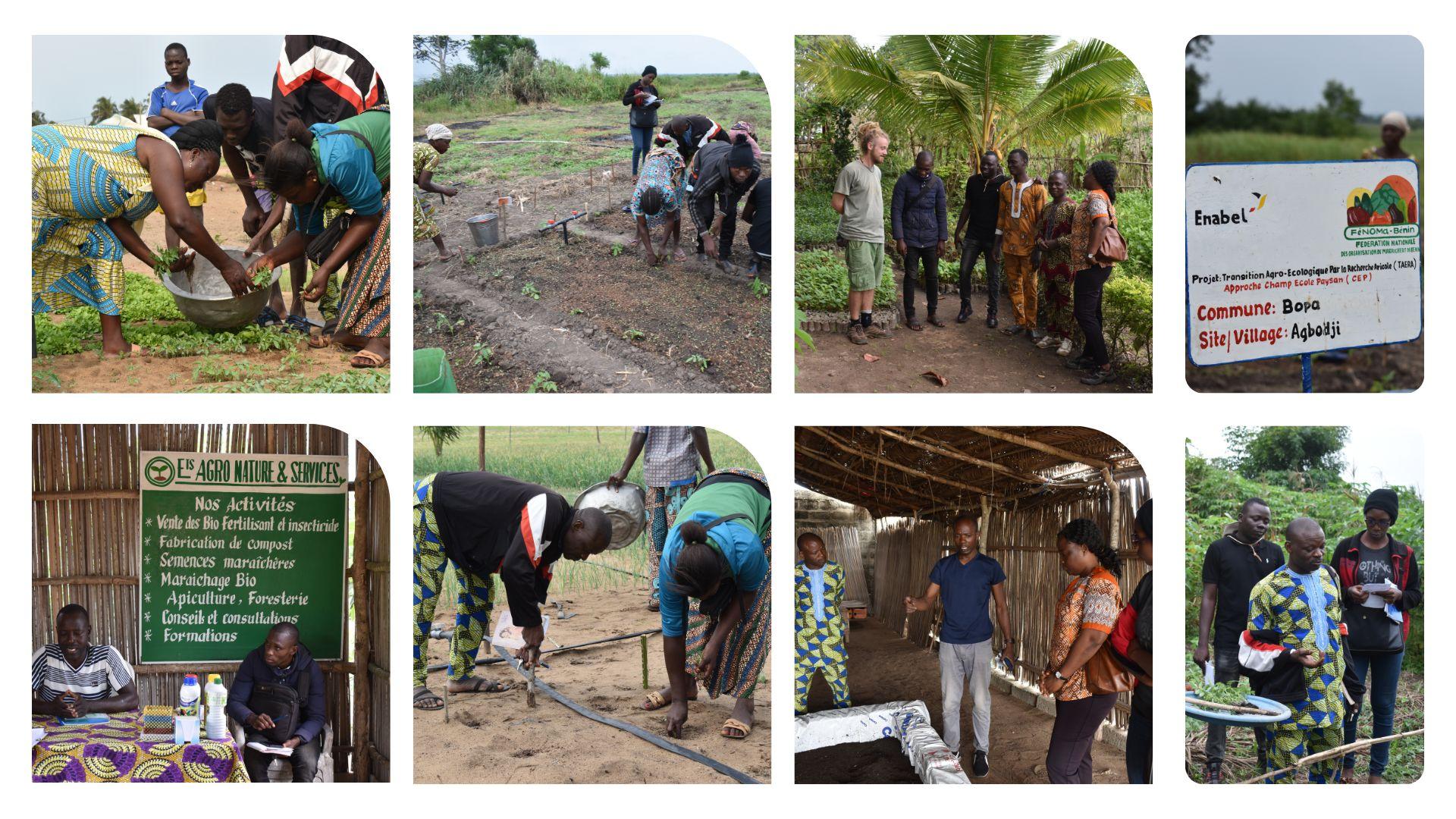
Bénin : 21 Champs-École Paysans sur l’agroécologie installés dans les filières riz et maraîchage
Reece-hermine ADANWENON | 08/09/2022
Mis en œuvre par Enabel Bénin, le Projet « Transition Agro Écologique par la Recherche Agricole » (TAERA) permets d’identifier, de tester et de diffuser des référentiels de « bonnes pratiques » économiquement intéressantes pour le producteur, socialement acceptables, et sans impact négatif sur l’environnement. Pour faciliter l’atteinte de ces objectifs, des collaborations ont été établies avec l’Université de Parakou et d’Abomey-Calavi ainsi qu’avec les faîtières nationales des filières Riz et Maraîchage. Ces collaborations visent le renforcement du dialogue entre les acteurs et la participation effective des producteurs aux recherches dont ils sont les utilisateurs finaux des résultats , ceci à travers les champs-écoles paysans (CEP). A ce jour, 21 CEP sont installés dans les filières riz et maraîchage. Le champ-école paysan représente un lieu d’apprentissage et d'expérimentation par les producteurs. Il est aujourd’hui l’une des nouvelles approches non formelle d’éducation des adultes qui s’est considérablement développée comme alternative aux méthodes de vulgarisation traditionnelles (dites "top down"). Cette approche permet également de créer ce lien indispensable entre les chercheurs et les producteurs pour tester et diffuser des innovations adaptées aux contextes locaux.Pour la filière riz, ce sont 13 CEP qui sont installés sur les 15 prévus d’ici 2024. Ils portent sur les techniques d’irrigation intermittente ou humidification et séchage alternés (SWD), le Système de Riziculture Intensive (SRI) associé à la technique de l'urée enrobée à l'huile de neem, sur les tests de variété orylux à cycle court et résiliente au changement climatique, sur le test de Vermis compost, et sur le SRI associé au vernis compost. Ces CEP sont suivis par 25 riziculteurs dont un relai. Les thématiques abordées portent une attention particulière sur la gestion intégrée de l’eau, la gestion de la fertilité du sol et le recyclage de résidus jusque-là inutilisés.Concernant la filière maraîchage, 08 CEP ont été installés sur les 50 prévus d’ici 2024 et portent sur des essais variétaux de tomates afin d’évaluer leur performance par rapport au flétrissement bactérien. Pour ce faire, 14 variétés jugés résistantes/tolérantes à RS sont testées avec les producteurs. Les CEP installés sont suivis par un groupe de 5 maraîchers dont le chef de file est le maraîcher relai.La sélection des relais, pour les deux filières concernées, s’est faite de manière participative par les doctorants, les faîtières et l’équipe du projet TAERA par commune à travers des assemblées communales. Un accent a été mis sur l’aspect genre. Ce qui a permis d’identifier 12 femmes relais sur 50 pour le maraîchage.D’autres thématiques seront expérimentées sur les CEP au fur et à mesure de l’évolution des activités du projet. Il s’agit entre autres de l’utilisation du haricot mungo (Vigna radiata) en rotation avec la culture du riz, de rotations diverses, de diverses méthodes d’irrigation.
-

#D4Dblogging : Le D4D Hub UA-UE lance un concours de blogs en Afrique et en Europe sur la désinformation en ligne
Ahtziri Alejandra GONZALEZ GARCIA | 08/09/2022
Le projet Digital for Development (D4D) Hub Union africaine – Union européenne (UA-UE), dont Enabel est un partenaire de mise en œuvre, invite les blogueur·euses d'Afrique et d'Europe à participer à son premier concours de rédaction de blogs : Comment l'Afrique et l'Europe peuvent agir ensemble pour lutter contre la désinformation et protéger les droits humains à l'ère numérique ?Le concours est ouvert à tou·tes les blogueur·euses intéressé·es par la liberté d'expression, la désinformation, l'internet ouvert et les droits et principes numériques. Il recherche des blogs qui présentent des points de vue originaux sur la manière de lutter contre la désinformation en ligne par le biais d'actions fondées sur les droits humains, qui sensibilisent aux problèmes en jeu et qui encouragent de nouvelles voies de collaboration Afrique-Europe dans ce domaine. L'appel à candidatures est ouvert jusqu'au 7 octobre 2022. Les blogs présélectionnés seront publiés sur le site web du D4D Hub UA-UE, et l’auteur·e du meilleur blog sera invité·e à se rendre à Addis-Abeba, en Éthiopie, pour assister à la Conférence sur la gouvernance de l'Internet (IGF) qui aura lieu du 28 novembre au 2 décembre 2022.Plus d'informations et formulaire de soumission : https://d4dhub.eu/d4dblogging
-

#D4Dblogging: AU-EU D4D Hub launches competition for African and European bloggers to share their views on online disinformation
Ahtziri Alejandra GONZALEZ GARCIA | 08/09/2022
The African Union – European Union (AU-EU) Digital for Development (D4D) Hub project, of which Enabel is an implementing partner, invites bloggers from Africa and Europe to participate in its first blogging competition: How can Africa and Europe work together to tackle disinformation and protect human rights in the digital age?The competition is open to all bloggers interested in freedom of speech, disinformation, open internet, and digital rights and principles. It looks for blogs that present original views on how to tackle online disinformation through human rights-based actions, create awareness of the issues at stake, and foster new ways for Africa-Europe collaboration in the fieldThe call for submissions is open until 7 October 2022. The shortlisted blogs will be published on the AU-EU D4D Hub’s website, and the author of the winning entry will be invited to travel to Addis Ababa, Ethiopia, to attend the Internet Governance Conference (IGF) from 28 November to 2 December. More information and submission form: https://d4dhub.eu/d4dblogging
-
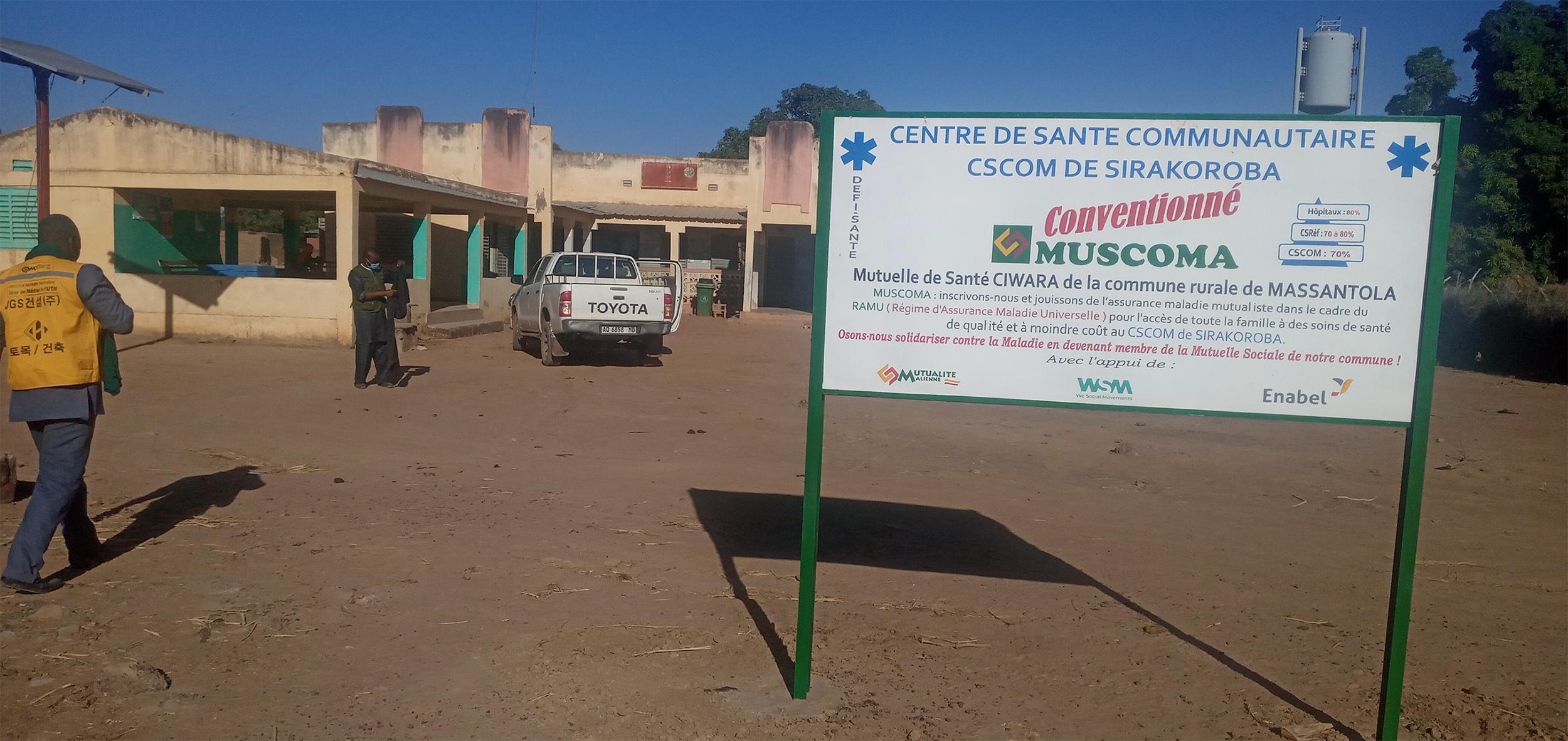
Au Mali, à travers le projet de lutte contre l’insécurité alimentaire et la malnutrition, le financement des soins en milieu rural est facilité
Nènè TRAORE | 06/09/2022
Amélioration de l’utilisation des services sanitaires pour les populations des secteurs agricoles et informels dans la région de Koulikoro.Au Mali, Enabel et ses partenaires WSM (We Social Movements)/l’Union Technique de la Mutualité malienne (UTM) ont contribué à améliorer la couverture de la population par les mutuelles dans les cercles de Nara, Kolokani et Banamba à travers le projet de lutte contre l’insécurité alimentaire et la malnutrition (LCIANK) au Mali. Le LCIANK est un projet multi-secteurs et multi acteurs qui a cherché à remédier aux problèmes de sécurité alimentaire et nutritionnelles avec pour objectif d’intensifier la production agricole de manière durable, moderne et compétitive, de valoriser les produits agricoles, notamment sur les exploitations familiales, et de promouvoir la sécurité alimentaire. Afin de parvenir à la sécurité alimentaire et nutritionnelle, un certain nombre de facteurs contributifs se sont révélés nécessaires, afin de conjuguer les efforts de manière à assurer la synergie et la complémentarité entre les partenaires de mise en œuvre. Situation de la protection sociale dans la zone d’intervention du projet Au Mali, malgré les efforts considérables déployés dans le secteur sanitaire, les indices d’utilisation des services de santé demeurent faibles. Le taux de contact des centres de santé par personne et par an est de l’ordre de 43 %1 au niveau national et de 24 % dans le district sanitaire de Kolokani, soit une moyenne de 33 %. L’inaccessibilité financière pour les populations à faible revenu reste un facteur déterminant de l’exclusion du système de santé.Pour juguler ce phénomène, les mutuelles de santé apparaissent comme une solution pour couvrir les 78 % des populations évoluant dans les secteurs agricoles et informels. Ainsi pour assurer un accès financier aux soins et une protection sociale en santé des populations rurales, il faut favoriser un accès durable aux mutuelles de santé, afin de réduire l’inégalité de l’accès aux soins de santé. Les stratégies utilisées pour apporter des éclaircissements sur le financement de la santé en milieu rural par les mutuelles de santé dans le cercle de Kolokani ont été les suivants : • Création et accompagnement des mutuelles de santé • Articulation avec l’offre de soins • Articulation avec les collectivités • Synergie et complémentarité pour une protection sociale améliorée.Pour mieux comprendre comment la création des mutuelles a booster la fréquentation des centres de santé, cliquez ce lien :https://sway.office.com/A0Y0WJI9eUsBQ3tM?ref=Link
-
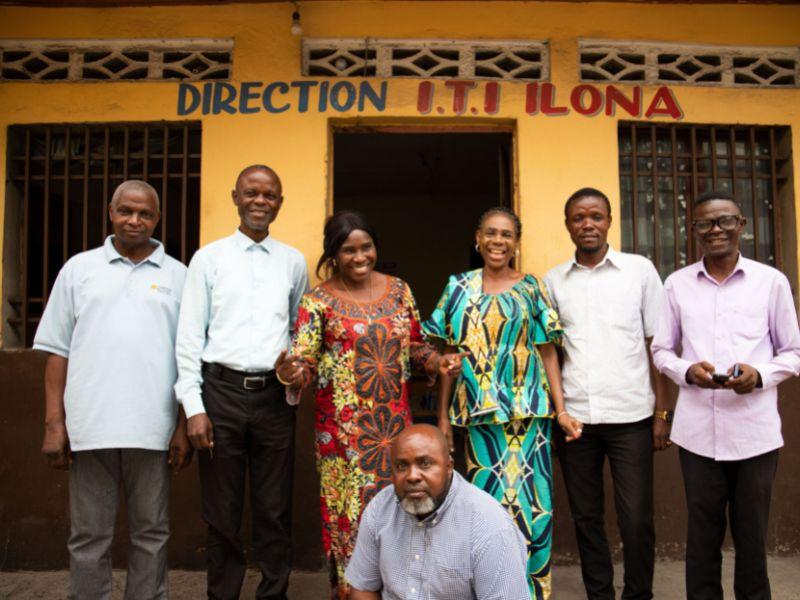
RDC: Une rentrée digitale pour 7 centres de formation professionnelle à Kinshasa
Philippine DE BRUYN | 06/09/2022
À quelques jours de la rentrée, les équipes du projet en RDC de Résilience au COVID-19 par la digitalisation (RESICODI) se sont rendues dans différents centres de formation technique, l’occasion de voir comment se prépare le personnel enseignant avec les nouveaux outils numériques en cours d’implémentation mais aussi d’échanger sur les implications d’une arrivée du numérique aussi bien au niveau des infrastructures que nouvelles manières d’enseigner. Au travers de témoignages de responsables de centres, découvrez les attentes et nouvelles perspectives amenées par l’arrivée de nouvelles classées informatiques et nouvelles compétences au sein de l’école. « Grâce à l’arrivée de cette nouvelle salle numérique et la formation de nos enseignants, nous espérons pour cette année que nos jeunes des différentes filières (maçonnerie, menuiserie, couture etc.) puisse apprendre aussi bien à manipuler l’outil numérique que d’apprendre à rechercher de nouvelles techniques spécifiques à leur futur métier. (…) En plus de cela, pour garantir une subsistance de la salle, nous avons ouvert une filière d’informatique spécifique où les écoles de la région mais aussi d’autres individus pourront venir se former à l’informatique ici chez nous. » - Père Jules César Batina, Don Bosco Kimbwala « Je suis très touchée que notre lycée de filles ait été choisi pour pouvoir installer une telle salle car, en général, nos filières couture et coiffure sont souvent délaissées. Pourtant, je suis persuadée qu’avec un bon outil numérique, nos élèves vont pouvoir perfectionner leurs techniques, découvrir de nouveaux outils et, à la sortie de leur formation, être capable de s’insérer plus rapidement soit dans la vie active ou dans des formations plus hautes. » - Jackie Bapile Musungu, Lycée Technique Gombe« J’ai augmenté le nombre d’heures informatiques. Nous sommes passés à 2 heures par semaine de bibliothèques numériques. Grâce à ces sessions j’espère que les élèves de chaque filière pourront effectuer des recherches et développer leurs connaissances à leur niveau. Les professeurs ont également adapté et réalisé des planifications pour introduire l’informatique dans leurs cours et expérimenter comment lier l’apprentissage traditionnel (en classe) et les ressources numériques. » - Père Georges Mukinayi, Don Bosco Masina« Dans notre école, nous avons bien compris que la digitalisation est semblable à une pierre précieuse que nous devons conserver et garder précieusement. Nous sommes conscients que cela implique des changements au niveau de l’organisation de l’école et qu’il faudra faire en sorte de pouvoir continuer à entretenir et utiliser ces ressources. » - Sœur Ernestine Muya, Don Bosco Sanga Mamba« Les parents des élèves en voyant cette nouvelle salle informatique sont enthousiasmés à l’idée de pouvoir inscrire leurs enfants dans notre école et qu’ils puissent bénéficier d’une éducation de qualité, en lien avec les outils modernes. » - Madame Chantal Mambweni Mayulu, I.T.I IlonaLes centres appuyés par RESICODI dans le cadre de la réhabilitation de salles informatiques et formation de professeurs sont les suivants:I.T.I IlonaIG Gombe 2CFP Don Bosco MasinaLycée Technique GombeCFP Don Bosco Sanga MambaCFP Don Bosco GombeCFP Don Bosco Kimbwala***Quelques mots au sujet de RESICODI (Résilience au COVID-19) par la digitalisationDans un esprit Team Europe, la GIZ et Enabel ont uni leurs forces pour tirer parti des projets existants afin d'assurer une réponse intégrée et durable au COVID-19. RESICODI soutient ainsi des initiatives en cours mises en œuvre par les deux agences :La GIZ renforce l'initiative BACKUP Fund établie pour fournir un soutien technique et financier aux partenaires africains travaillant sur des solutions numériques pour les services d'éducation de base.Enabel renforce les projets réussis de l'enseignement et de la formation techniques et professionnels (EFTP) et de santé pour faciliter la résilience au COVID-19.Le projet est mis en œuvre au Botswana, au Burundi, en République démocratique du Congo, à Madagascar, au Malawi, en Namibie, au Rwanda et en Zambie.
-

Bénin: Enabel facilite le partage d’outils entre les professionnels de la lutte contre la cybercriminalité
Reece-hermine ADANWENON | 05/09/2022
L'amélioration de la lutte contre la cybercriminalité au Bénin à travers :Le renforcement des capacités en matière d’analyse criminelle et de planification stratégique,L’appui à la mise en œuvre du plan de lutte contre la cybercriminalité,La création des partenariats avec le développement des réseaux.c’est l’un des résultats attendus du projet d’appui à l’opérationnalisation de la Police Républicaine (PAOP) mis en œuvre par Enabel au Bénin. Pour y parvenir, Serge HOUTAIN, expert consultant en informatique de la police fédérale belge était au Bénin pour partage de connaissances et d’expériences avec les membres de l’Office central de répression de la cybercriminalité au Bénin. Durant 2 semaines ces hommes en uniforme ont été outillés et formés afin d’optimiser l’enregistrement des infractions en matière de cybercriminalité. Ils ont également pu renforcer leurs compétences en investigation ceci grâce à l’appui technique et financier du projet (PAOP) de l’Agence belge de développement « Enabel ». Dans cette vidéo écoutons les au terme de la formation.
-
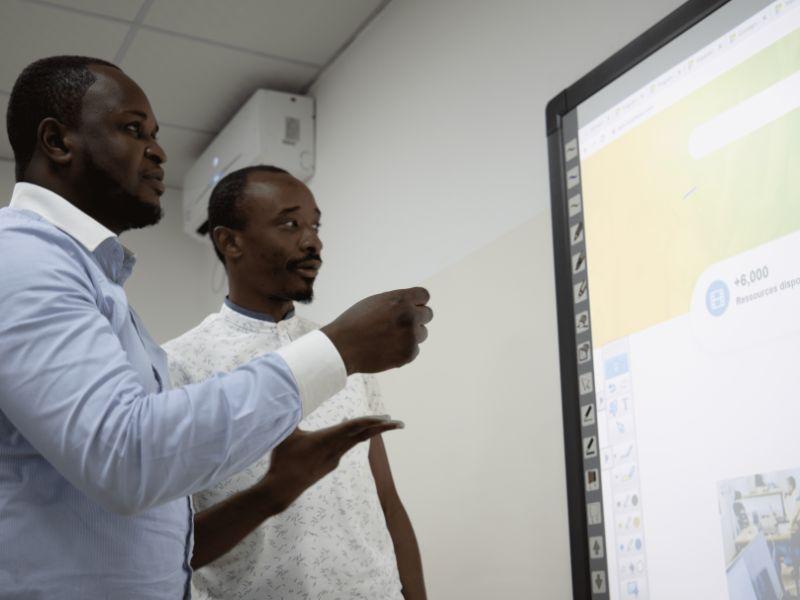
RDC: Développement d'une bibliothèque numérique innovante et orientée sur l'utilisateur
Philippine DE BRUYN | 05/09/2022
Le projet de résilience au COVID-19 par la digitalisation (RESICODI), co-financé par l’Union Européenne, vise à renforcer des capacités et services dans le domaine de l’éducation et la santé. À cette occasion, nous avons rencontré Cédrick Ngandu Kalala et Nelson Mbembe, deux collègues d’Enabel en RD Congo. Ils nous expliquent comment ils en sont arrivés à développer, en partant de rien, une bibliothèque numérique centrée sur l’utilisateur pour ce projet. Vous êtes tous deux experts au sein de l'équipe D4D - Digital for Development - d'Enabel. Pouvez-vous nous expliquer brièvement en quoi consiste votre fonction ?Cédrick Ngandu Kalala : Mon titre de fonction officiel est D4D expert mais pour le projet RESICODI, je fais également officer d’Intervention Manager. En d’autres termes, je suis en charge de la mise en œuvre du projet, implémentation de toutes les activités au niveau santé et éducation mais je dirige également les réflexions concernant les solutions à mettre en place, le suivi et les tâches en rapport avec la gestion du projet.Nelson Mbembe : De mon côté, je suis ICT officer en charge du renforcement des capacités numériques. Je m’assure principalement de pouvoir poser les bases d’une bonne alphabétisation numérique pour les écoles et enseignants afin que le projet puisse suivre son cours de la meilleure façon possible. Cela signifie que nous assurons le suivi logistique de la réhabilitation des salles, le suivi des formations mais également le support technique pour les différentes plateformes et matériel ICT.Vous êtes en train de développer une nouvelle bibliothèque numérique de quel constat est partie cette idée ?C. : Nous étions surtout guidés par l’envie de développer un projet pilote innovant et l’envie de tester une nouvelle solution pour mettre à disposition des ressources éducatives libres aussi bien au projet RESICODI qu’Enabel en RD Congo.N. : Si nous avons eu l’envie de développer cette solution c’est principalement car nous sommes partis du constat que d’un point de vue technique, les spécificités proposées par d’autres solutions ne correspondaient pas toujours aux besoins énoncés par les enseignants et apprenants. Dès lors, il s’imposait à nous de pouvoir recréer quelque chose facile d’utilisation où nous pourrions avoir la main à 100%.Quels sont les avantages de cette bibliothèque ? À quel public est-elle destinée ? C. : Idéalement, le plus gros avantage de cette solution serait d’améliorer la qualité de l’apprentissage et de l’enseignement en général. Nous avons la possibilité de donner accès à plusieurs ressources sans pour autant avoir besoin d’équipements spécifiques comme une bonne connexion internet.N. : Cette solution est destiné aux centres de formation professionnelles, enseignants et apprenants. Quels sont les challenges dans le développement d’une telle bibliothèque ?C. : Ce qui nous a posé beaucoup question c’était l’identification des plateformes au niveau technique. Il est évident que d’autres plateformes proposaient également certaines spécificités et dès lors l’évaluation des besoins et les réflexions autour de la bibliothèque ont été assez longues.N. : De mon point de vue, ce qui reste compliqué à ce jour c’est de pouvoir centraliser et trouver les ressources éducatives libres à utiliser. Il est difficile de trouver aussi du contenu en français. Nous sommes d’ailleurs en train de former les enseignants afin qu’ils puissent produire eux-mêmes les ressources éducatives.Comment la solution est-elle accueillie ?C. : À ce stade du projet, les enseignants sont évidemment motivés à utiliser la bibliothèque dans leurs cours. Néanmoins, je reste prudent quant à l’utilisation sur le long-terme. C’est pourquoi nous accordons une importance toute particulière à l’approche et l’accompagnement de changement. En leur démontrant à quel point cette solution numérique peut apporter un plus dans leur vie professionnelle quotidienne et en leur fournissant le support nécessaire, nous espérons que cela ne devienne pas une charge mais qu’ils s’approprient réellement la solution.N. : J’ai également déjà pu discuter avec des enseignants qui ont testé la bibliothèque, ils apprécient sa facilité d’utilisation et surtout le fait qu’elle soit accessible à distance. Nous discutons beaucoup avec eux sur la façon dont ils vont implémenter ça par la suite dans leurs classes.Il y a-t-il une approche innovante qui est abordée par Enabel ? Qu'est-ce qui est spécifique à ces activités ?C : Ce que nous avons voulu instaurer dans le projet RESICODI, c’est une véritable motivation d’apprentissage dès le premier maillon de la chaine d’apprentissage : les enseignants. En leur permettant de passer une certification reconnue internationalement (Certiport) nous voulons leur permettre d’ouvrir d’autres champs de possibles et participer à une véritable communauté d’enseignants. Cela leur permet de jauger l’efficacité de la formation et participer à des échanges constructifs d’idées. J’aimerais aussi mentionner qu’une autre approche innovante du projet est que nous avons décidé d’également intégrer des populations ayant tendance à être délaissées tant au point de vue situation géographique ou financier. En proposant des programmes de codages dans trois centres dans de quartiers plus reculés de Kinshasa nous désirons permettre à ces populations plus jeunes d’avoir également accès à ce type de formation dans leurs quartiers et à moindres coûts.N. : Pour moi, le fait que nous ayons eu l’opportunité de développer un projet pilote de bibliothèque numérique de A à Z est une approche très innovante pour moi. J’ai aussi également apprécié que nous ayons pu, dès le départ associer les enseignants au développement pour nous assurer que tout évoluait selon leurs attentes et besoins.Quelles sont vos attentes sur le long terme ? Comment s’assurer que cette solution sera encore utilisée ?C. : Je dirais que sur le long terme nous allons devoir nous focaliser sur deux aspects. Le premier réside dans l’accompagnement technique. Nous voulons nous assurer que les utilisateurs principaux ont une certaine maitrise de la gestion et utilisation de l’outil. En effet, pour une personne ayant déjà l’habitude de préparer ses cours d’une certaine façon (utilisation de livres, supports imprimés etc.) il est important de pouvoir accompagner la transition et lui permettre de se détacher petit à petit de certaines habitudes pour créer une flexibilité et un mix dans l’approche éducative. C’est pour cela que nous avons parié sur la flexibilité et calibré au mieux les requêtes par rapport aux différentes réalités rencontrées dans les centres (nombre d’élèves, infrastructures, professeurs…). Ensuite, nous aimerions nous assurer que cette solution puisse également être déployée sur d’autres projets. En effet, nous voyons toute la pertinence d’utiliser cette solution également dans le secteur de la santé et nous espérons que par notre travail de transition et accompagnement, cette solution puisse s’adapter à d’autres projets et secteurs.N. : J’aimerais vraiment que les enseignants s’approprient la bibliothèque et en fassent quelque chose de pérenne, une part entière de leur méthodologie au cœur de leur enseignement. Si on parvient à leur transmettre notre enthousiasme et passion pour cette bibliothèque numérique alors je suis confiant que ça ne va pas être un coup dans l’eau. Quelques mots au sujet de RESICODI (Résilience au COVID-19) par la digitalisationDans un esprit Team Europe, la GIZ et Enabel ont uni leurs forces pour tirer parti des projets existants afin d'assurer une réponse intégrée et durable au COVID-19. RESICODI soutient ainsi des initiatives en cours mises en œuvre par les deux agences :La GIZ renforce l'initiative BACKUP Fund établie pour fournir un soutien technique et financier aux partenaires africains travaillant sur des solutions numériques pour les services d'éducation de base.Enabel renforce les projets réussis de l'enseignement et de la formation techniques et professionnels (EFTP) et de santé pour faciliter la résilience au COVID-19.Le projet est mis en œuvre au Botswana, au Burundi, en République démocratique du Congo, à Madagascar, au Malawi, en Namibie, au Rwanda et en Zambie.
-
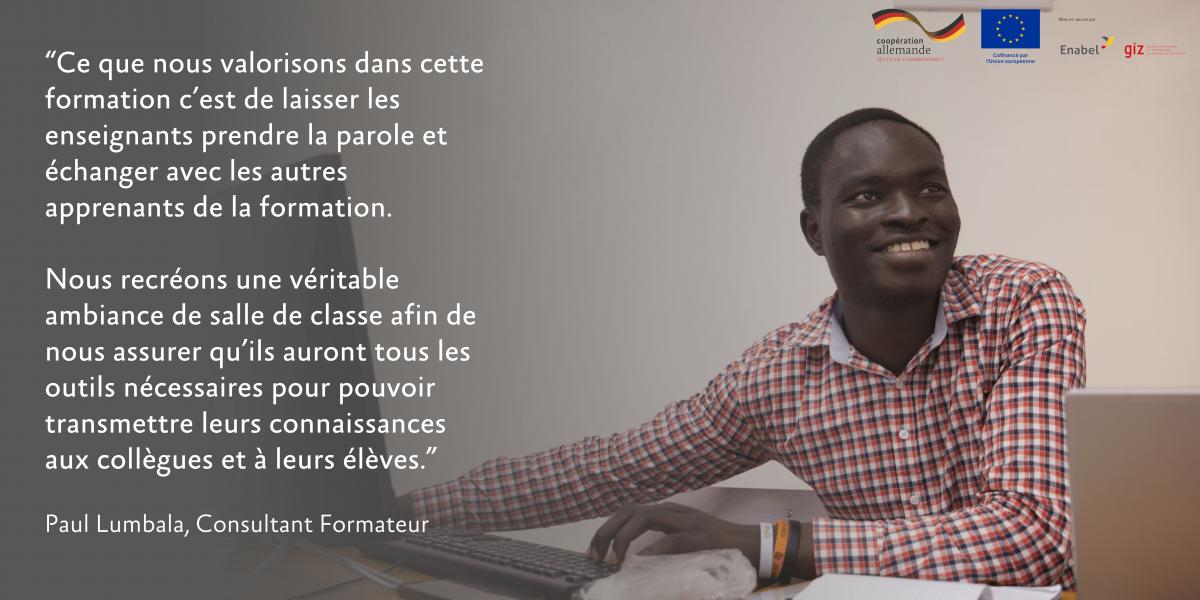
RDC: L'accès à une formation de qualité en compétences numériques pour les enseignants, une condition indispensable pour l'enseignement digital!
Philippine DE BRUYN | 05/09/2022
Paul Lumbala est consultant formateur en compétences numériques de base (Microsoft Certified Educator via NITDSolutions). Dans le cadre du projet, co-financé par l’Union Européenne de Résilience au Covid-19 par la digitalisation (RESICODI), différentes actions et activités sont organisées afin de renforcer les services et compétences en matière de numérique en matière d’éducation. La formation organisée dans le cadre de ce projet est destinée à 14 enseignants (issus de 7 centres différents) pendant 15 jours et deux certifications à la clé. Les programmes répondant à ces deux exigences et retenus sont respectivement l’IC3 (Internet Core Computing Certification IC3) et le Microsoft Certified Educator (MCE). Quelles sont vos tâches principales ? L’objectif principal de la formation est de dispenser aux apprenants les fondamentaux de l’ordinateur constituant ainsi une phase d’alphabétisation numérique mais aussi de les accompagner dans la maitrise des outils numériques au profit de l’enseignement. La méthodologie se présente en 3 parties essentielles qui sont l’apprentissage, la pratique et la certification. Je produis donc un contenu qui s’adapte à la demande tout en le gardant le plus pratique possible ce qui correspond à la première phase qui se termine bien entendu par la formation en présentiel. Ensuite dans la deuxième et la troisième phase, nous accompagnons l’apprentissage par la pratique. Ces outils sont notamment présentés sous forme de vidéos d’apprentissage, de tests blancs en ligne et enfin de tests réels et sécurisés en ligne. Cet ensemble est donc mis à contribution pour accompagner les apprenants vers la maitrise du sujet de la formation. Il faut enfin noter que le programme IC3 comprend trois parties essentielles qui sont les fondamentaux, les applications clés (Word, Excel et Powerpoint) et enfin la citoyenneté numérique. Comment pourriez-vous caractériser l’approche de la formation ? Ce que nous valorisons dans cette formation c’est de laisser les enseignants prendre la parole et échanger avec les autres apprenants de la formation. Dans cette optique, ils ont le temps de faire des recherches pour ensuite créer leur propre contenu, les présenter aux autres collègues pour ensuite échanger avec eux. Nous récréons une véritable ambiance de salle de classe afin de nous assurer qu’ils auront tous les outils nécessaires pour, par la suite, pouvoir transmettre leurs connaissances aux collègues de leur école respective mais aussi, et c’est le plus important, à leurs élèves. Ensuite, l’idée d’avoir une certification internationale (Certiport) à la suite de la formation permet de remettre tout le monde à niveau et de retrouver un cadre avec des normes et standards qui leur permettront d’avoir une crédibilité à d’autres niveaux externes. Pendant tout le processus les apprenants sont régulièrement testés avec des tests blancs afin de se préparer au mieux à la certification, identifier leurs besoins et pouvoir travailler sur leurs lacunes. Quelle est la spécificité de la formation dans le cadre du projet RESICODI ? Ce qui est assez apprécié et étonnant c’est que les responsables du projet participent activement à la formation pour en connaitre tous les détails et pouvoir, par la suite, être au courant des tenants et aboutissants. Les outils mis en place, notamment la plateforme en ligne, permettront un suivi détaillé de cette partie du projet et en temps réel. Les statistiques sont créés et stockées automatiquement en ligne. Comment cette formation est-elle accueillie auprès des enseignants ? Il faut tout d’abord savoir que ces étudiants participent à la formation sur base volontaire et pendant leurs vacances. A ce stade, les échanges au sujet de la formation sont plutôt positifs car cela leur a permis de découvrir de nouveaux outils, accéder à une multitude de nouvelles ressources mais aussi rejoindre une communauté internationale d’enseignants. Que percevez-vous comme bénéfice à la digitalisation de certains services d’éducation ? Grâce à ces formations nous espérons pouvoir donner les clés aux enseignants pour pouvoir transmettre leurs nouvelles compétences à leurs collègues enseignants et élèves. Ce transfert de compétences peut, d’après moi, véritablement améliorer la qualité de l’apprentissage, faire sauter certaines barrières géographiques et mieux préparer à certaines situations de total isolements telles que nous les avons connues avec le COVID-19. J’y vois également une énorme possibilité de développer des échanges qualitatifs entre les enseignants et repenser l’éducation pour préparer au mieux les élèves pour le futur.
